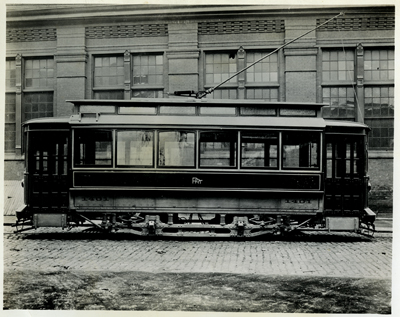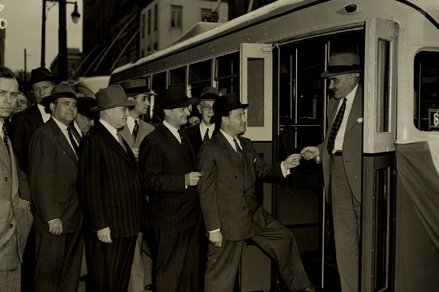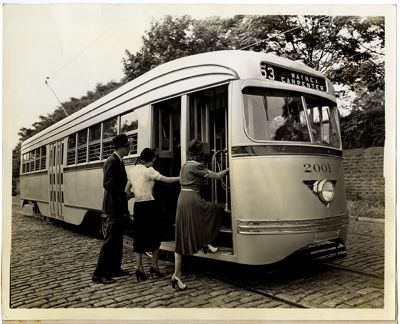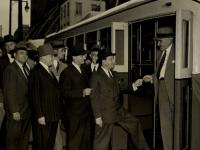As an intern with the Greenfield Digital Project, I’ve been working through the summer and the fall researching organizations related to the Bankers Trust story. So far I’ve been most excited about the story of Philadelphia Rapid Transit Company, the predescessor to Southeastern Pennsylvania Transportation Authority (SEPTA), and its president from 1911 to 1929, Thomas Mitten.
Philadelphia Rapid Transit was incorporated in 1902, and began construction of electric streetcar lines to West Philadelphia, as the affluent and fashionable suburb was developing rapidly. Within the year, PRT made plans for the city’s first subway line running under Market Street (predecessor to today’s Market-Frankford Line), completed in 1907, as well as a street-surface line on Broad Street.

Electric PRT trolley, 1902 (Philadelphia Record Photograph Morgue Collection, no. V7).
The company planned and grew at exponential rates in the early 20th century, but its management was inefficient, secretive, and grossly unpopular with the public. By the time the Market Street line was complete, PRT was nearly bankrupt, and its poor financial decisions trickled down to fed up workers. Hoping to piggyback on the public’s dissatisfaction with PRT’s recent fare increases, streetcar drivers decided to strike for higher wages and better conditions in May 1909.
As someone who rides SEPTA almost every day, it’s not hard for me to imagine Philadelphia public transit inciting riots in the streets, although labor unrest on this scale seems foreign to me in 21st century. On the afternoon of May 29th, 1909, strikers gathered all over the city, especially concentrating in streetcar suburb areas like West Philadelphia, Frankford, Brewerytown, and Germantown. The strikes turned violent after sunset: strikers gathered into unruly groups that at some points swelled to over 600 men. Some left dynamite on trolley tracks, vaulted rocks into crowds, stormed trolley cars, and uprooted supportive trolley poles.
Damages to the transit network tied up almost all of the lines in Philadelphia for days. The strike was eventually called off after negotiations between the PRT unions and management began, but the company continued to experience extreme labor unrest, including another long and violent strike, into 1910.
Enter Thomas Mitten, an Englishman who was installed as PRT president in late 1911, after the former president, Charles E. Krueger, dropped dead of a heart attack at his clubhouse earlier in the year.

Greeting riders aboard a PRT trolley. Albert M. Greenfield is third in line (Albert M. Greenfield Papers, collection no. 1952).
I was excited to learn about Mitten and PRT’s labor solutions: breaking clean of the conflict-ridden, top-down model of negotiations between company management and the two PRT unions, Mitten instead developed his “Cooperative Plan,” which earmarked 22 percent of all company earnings for wages, pensions, and other benefits. By late 1912, Mitten had installed the Cooperative Welfare Association, which organized employee sick and death benefits, and provided for co-op buying of food and other consumer goods for employees. PRT was fairly unique in its labor dealings, and employees resisted outside unions like the Amalgamated Association through the 1920s.
PRT’s fortune under Mitten rose with the all but too common seedy financial practices of the 1920s, and fell dramatically when the system became unstable later in the decade. After some questionable business gambles, the company went up for sale to the city in 1927. In September 1929, still heading the company, the city began an investigation against Mitten citing “excessive fees and diversion of funds.” A month later Mitten was found dead, drowned in his summer home in the Poconos. The Great Depression halted transit construction in Philadelphia, and the transit workers cooperative ended with PRT’s downfall.

Germantown trolley, 1939. (Philadelphia Record Photograph Morgue Collection, no. V7)
In 1940, PRT was officially reorganized into Philadelphia Transportation Company (Albert M. Greenfield, the star of our Bankers Trust project, was one of two men who led the reorganization of the company!). The old company union was long gone by the mid-‘40s, and employees were organized by the Teamsters and the Transit Workers Union. Control of the city’s transit lines passed to National City Lines in the 1950s, which was then consolodated into SEPTA in 1968.

